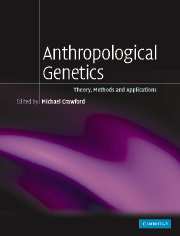Book contents
- Frontmatter
- Contents
- List of Contributors
- Preface
- Chapter 1 Foundations of Anthropological Genetics
- Part 1 Theory
- Part 2 Methods
- Part 3 General Applications
- Part 4 Part IV The Human Diaspora
- Chapter 12 Human Origins Within and Out of Africa
- Chapter 13 The Peopling of Europe
- Chapter 14 The Peopling of Oceania
- Chapter 15 The Prehistoric Colonization of the Americas
- Chapter 16 Anthropological Genetics: Present and Future
- Index
- References
Chapter 14 - The Peopling of Oceania
Published online by Cambridge University Press: 05 June 2012
- Frontmatter
- Contents
- List of Contributors
- Preface
- Chapter 1 Foundations of Anthropological Genetics
- Part 1 Theory
- Part 2 Methods
- Part 3 General Applications
- Part 4 Part IV The Human Diaspora
- Chapter 12 Human Origins Within and Out of Africa
- Chapter 13 The Peopling of Europe
- Chapter 14 The Peopling of Oceania
- Chapter 15 The Prehistoric Colonization of the Americas
- Chapter 16 Anthropological Genetics: Present and Future
- Index
- References
Summary
The peopling of the Pacific is particularly fascinating as it involves one of the earliest migrations of modern humans, the settlement of Australia and New Guinea, and the last major colonization event, the settlement of Polynesia. It required crossing vast distances of open ocean in small double-hulled canoes, suggesting highly developed sailing and navigational skills. The deep chronology, combined with the variations in Pacific environments, make the Pacific an ideal region to study colonization, adaptation, human genetics and human biology. This is not because islands represent laboratory conditions (Vayda and Rappaport, 1963), but because Pacific islands represent a range of environments and, perhaps, unique historical conditions that allow us to study the many factors that affect human variation.
The general geographic setting has significant implications for the settlement history and human biology in any region, but this is dramatically so in the Pacific. Most people are familiar with the original biogeographic dissection of the Pacific into Melanesia, Polynesia and Micronesia. While these crudely descriptive terms define the three regions as the ‘black islands’, ‘many islands’ and ‘small islands’, this familiar system of classification makes no sense in terms of biology, language and culture. So, prehistorians like Roger Green and others (Pawley and Green, 1973; Green, 1991; Kirch, 2000) have suggested an alternative system identifying two significant regions in the Pacific, Near Oceania and Remote Oceania, shown in Figure 14.1. This classification is based primarily on colonization history and, therefore, has biological, cultural and linguistic significance.
- Type
- Chapter
- Information
- Anthropological GeneticsTheory, Methods and Applications, pp. 409 - 432Publisher: Cambridge University PressPrint publication year: 2006



